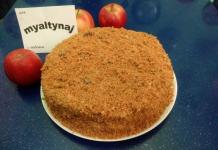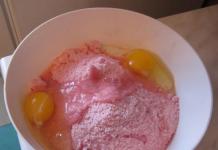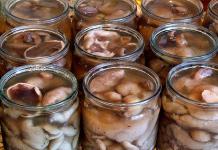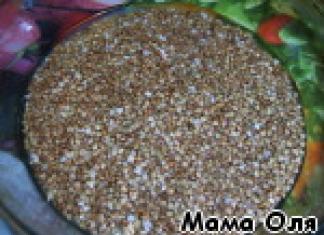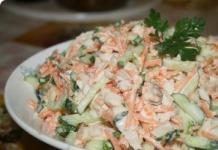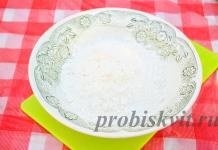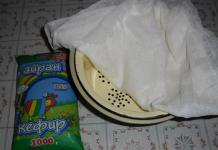Hello everyone! =))) I haven't been here for a long time, so don't be surprised that the title is so outlandish))) Moreover, I really love and can eat it almost every day in the form of a salad.
But the purpose of the article is not to tell about my passions, but to figure out how to plant such cabbage, how to care for it and when to harvest it. So let's go ...
Personally, I would define Peking cabbage like this: cabbage salad. Indeed, these elongated cabbage heads do not have a pronounced cabbage taste. Moreover, they are tender, like lettuce leaves.

Peking's leaves are tender, like lettuce
The average length of a head of cabbage is up to 60 cm. Peking cabbage is eaten both raw and after heat treatment - that is, it is prepared like ordinary cabbage.

Peking cabbage is very healthy. More than 16 essential amino acids, vitamins, without which the human body suffers greatly ... By the way, most of all this goodness is contained not in green leaves, but in their white cores, so do not try to cut them out!
In stores, Chinese cabbage is sold in this form:

But, you must admit, something of your own is always better than a purchased one. If earlier "petsai" was a rarity, now it is planted both in Russia and in Ukraine, so there is no particular shortage. pay attention to brief description vegetable:

Let's develop what has been said.
Landing
If we live in central Russia, it is most favorable to plant Peking cabbage with seedlings. To do this, in early April, we sow seeds for seedlings at home.
Everything is the same as when planting ordinary cabbage. Moderate watering and loosening, the temperature is low, about + 15 ° C. To increase germination and accelerate growth, you can use any of the existing mineral complexes.
You can choose the seeds of this crop in our market, which unites large online stores. Chapter .
Peking cabbage F1 Autumn Beauty
13 rbl
Russian Vegetable Garden
Peking cabbage F1 Manoko
39 rbl
Russian Vegetable Garden
Peking cabbage F1 Autumn Jade
13 rbl
Russian Vegetable Garden
Peking cabbage F1 Cha-cha
39 rbl
Russian Vegetable Garden
When the seedlings have 3-4 true leaves, they can already be planted in open ground. Optimally - in early May, although, again, look at the weather. It happens that it snows in May)). It is better not to plant in the cold, this will only contribute to further shooting.

If you plan to grow Chinese cabbage for (that is, for consumption in the fall, and not immediately), you can plant it directly in the ground in late June - early July. The distance between the plants should be 35-45 cm. Do not think that this is a lot, because this cabbage, like any other, has lower leaves that need to grow somewhere before the head is formed. In addition, Peking cabbage needs freedom as one of the important factors preventing the flowering (shooting) of plants.

Peking cabbage loves fertile soils with ample amounts. When planting, you need to take into account the fact that this is a plant of long daylight hours. But: If you don't want her to flower stalks, plant in a place with no more than 12 hours of daylight. If there is more than 12 hours of daylight, you will have seeds, but you will not have good cabbage. Favorable temperature: +16 ... + 20 ° С.
By the way, an important feature: almost all varieties Chinese cabbage have a short growing season - up to 60 days. Therefore, choose for yourself when to plant it, based on the time when you want to get strong and juicy heads of cabbage.
Care
Care should include the following “procedures”:Loosening and watering
the row spacing will provide oxygen access to the roots, which is needed to improve metabolic processes. In addition, it will facilitate the flow of moisture to them when watering. as necessary as regular cabbage. Make sure that the soil does not turn into a swamp, where they readily develop, and the heads of cabbage rot, - the water should not stagnate around them.Thinning of seedlings
Relevant when planting cabbage directly into the ground. However, for seedlings too. Thin twice: when two leaves have appeared (leaving a distance between the plants of 7 cm) and when the seedlings grow a little, after 10 days, leaving 20-40 cm between the plants.Pest control
The usual one is very effective. The main "enemies" of Peking cabbage are cabbage flies and fleas. To combat flies, the following is also often done: they shovel the soil off the plant stem and sprinkle the soil there from the rows. Allegedly, eggs laid by cabbage flies are removed along with the soil.Harvest
There may be 2 options. Peking cabbage is planted either on greens and used as a salad, or on heads of cabbage.- In the first case, the leaves are cut when they reach a height of 10 cm.
- If the final product is a head of cabbage, then they wait for the leaves to close at the top. Do not forget about the vegetative period: if 2 months have passed since planting, feel free to cut the heads of cabbage.
This cabbage is stored for no more than 3 months, so do not stock up for the whole winter, but eat it while it is tasty and healthy;)

Peking cabbage varieties
There are a lot of varieties and hybrids, it's true. I'll tell you about the main ones. Let's start with the head varieties. Among them, the variety has gained great popularity " Asten ", "Wineglass", "Vorozheya ", "Sorceress ", "Manoko ", "Nika" and " Cha-cha "... All of them are resistant to flowering, tender and juicy. What are their differences? Slightly different shape of heads of cabbage. For example, the Asten variety:
Peking cabbage "Asten". Photo from the sitefoodandhealth.ru
And here is "Vorozheya":

"Vorozheya" variety. Photo from the site uhodvdomashnihusloviah.ru
Among the leafy varieties, mention should be made of the variety "Khibinskaya"... It can be planted in open ground, and protected. And here, in fact, she is - khibinskaya kale:

Khibinskaya kale. Photo from the site pfaf.org
Use kale in the same way as a regular salad.
Have you ever planted Chinese cabbage? =)
Peking cabbage (lat. Brassica rapa subsp.pekinensis), or petsay, or Chinese cabbage, or salad cabbage- one of the subspecies of turnips, vegetable crop, herbaceous plant family Cruciferous. The first mentions of it date back to the 5th-6th centuries A.D. - then it was used not only as a vegetable, but also as an oil plant. As a cultivated plant, Peking cabbage was formed on the territory of China, and through the Korea Peninsula, it came to Japan and Indochina, where it became one of the most important garden crops. By the middle of the 20th century, hybrids of high yield and early maturity were created on the basis of Chinese and Japanese varieties of Peking cabbage. Until the 70s of the last century, this Far Eastern culture was not widespread in the United States and Europe, but now, thanks to the emergence of early ripening Japanese hybrids, the industrial cultivation of Peking cabbage in the open field is experiencing an unprecedented rise.
Listen to the article
- Landing: sowing seeds for seedlings - in late March or early April, planting seedlings in a vegetable garden - in late April or early May. Sowing seeds of late varieties in open ground - in July.
- Lighting: bright sunlight.
- The soil: light, loose, fertile, moderately moist, well-drained, neutral. The best soil- loamy.
- Watering: regular: once a week in the early morning or after sunset.
- Top dressing: two weeks after planting the seedlings with a solution of mullein, bird droppings or herbal tincture at the rate of 1 liter per 1 plant. Spring cabbage is fertilized 3 times during the growing season, summer cabbage - 2 times. Foliar dressing with boric acid solutions is popular.
- Reproduction: seed.
- Pests: spring cabbage fly, wavy flea, harmful centipede, cabbage moth, moth, scoop, bedbug and aphids, root and rapeseed burrowers, rapeseed bugs and flower beetles, bear, turnip whiteworm, winter and garden scoops, sprout fly, gamma scoop, dark cracker and wireworm, petiole gnat, black and cruciferous fleas and slugs.
- Diseases: black leg, black ring spot, tracheomycosis (fusarium wilting), phomosis (dry rot), vascular bacteriosis, mosaic, downy mildew, keela, leucorrhoea, white rot and alternariosis.
Read more about the cultivation of Chinese cabbage below.
Chinese cabbage - description
Peking cabbage is a biennial plant cultivated as an annual. Peking cabbage leaves, tender and juicy, with a flat or triangular median vein, form a loose head of cabbage or rosette. The leaves have wavy or jagged edges, they are slightly bumpy on the inside, their color can vary from a light yellow to bright green. Sometimes on the veins of leaves from the outside there is a slight pubescence. The leafy forms of the plant are used to prepare salads, and soups are cooked from heads of cabbage, garnishes are prepared, they are pickled and dried. In East Asia, pickled Peking cabbage is prepared, calling it kimchi.
Peking cabbage is a close relative of cruciferous crops such as radishes, radishes, turnips, turnips, turnips, rutabagas, horseradish, mustard, kohlrabi, daikon, savoy cabbage, Brussels sprouts, broccoli, cauliflower, cabbage and red cabbage.
We will tell you how Peking cabbage is grown and taken care of in a greenhouse, we will describe the conditions for growing Peking cabbage and tell you how to plant Peking cabbage in the ground, how to grow Peking cabbage in the open field, how to protect it from pests and diseases, why Peking cabbage cabbage blooms, and we will also bring to your attention a description of the varieties and useful properties of Peking cabbage.
When to sow Chinese cabbage for seedlings
The cultivation of Peking cabbage is carried out using a seedling and seedling method. Peking cabbage is a cold-resistant plant - its seeds germinate at a temperature of 4 ºC, but normal growth and development of the culture begins only at a temperature of 15-22 ºC. At higher temperatures, Chinese cabbage turns into color, especially in conditions of long daylight hours. That is why it is recommended to use the seedling method of growing a crop, which allows you to get the first crop already 3-4 weeks after planting seedlings in the ground.
Peking cabbage seeds are sown for seedlings about a month before the seedlings are planted in open ground - in late March or early April if you want to get an early harvest, and at the end of June if you need Chinese cabbage for winter consumption.

Growing Chinese cabbage seedlings
Sowing seeds of Peking cabbage is carried out in loose soil, for example, a soil mixture of two parts of coconut substrate and one part of humus. However, the problem of this culture is that it is hard to go through a dive, so it is preferable to sow seeds not in a general container, but three pieces in separate peat pots or peat tablets - in this case, you will not have to injure the seedlings either when diving or when transplanting into open ground. Dry seeds are embedded in a moist substrate to a depth of one and a half centimeters and placed in a dark, warm place until the seeds germinate.
A few days later, when shoots appear, the crops are brought out into the light. The temperature of the seedlings at this time should be no higher than 7-8 ºC - keep the seedlings on a glassed-in balcony or loggia.
How to care for Chinese cabbage during this period? Watering is carried out with warm, settled water as needed, when the upper layer of the substrate dries up, after watering, the moist soil is carefully loosened. When the grown seedlings of Peking cabbage develop 2-3 true leaves, only one of the strongest seedlings is left in the pots, and the weak ones are pinched off so as not to pull out the roots of the remaining seedling.

Peking cabbage pick
As we already wrote, in view of the fact that the seedlings of Peking cabbage do not tolerate a dive well, you need to sow its seeds not in a common dish, but in separate containers in order to avoid injury to the roots of seedlings when diving and transplanting into open ground.
Planting Chinese cabbage in open ground
When to plant Chinese cabbage in the ground
Growing and caring for Peking cabbage in the open field begins with planting its seedlings in the garden. Peking cabbage is planted at the stage of development in seedlings of 5-6 true leaves, when at least three weeks have passed since the emergence of seedlings.
10 days before planting, the seedlings begin to harden - the seedlings are taken out into the yard for a short time every day, gradually increasing the duration of their stay in the fresh air. When the seedlings can spend the whole day in the yard, they are ready for planting in the garden. 3-4 days before transplanting, the seedlings are no longer watered so that the seedlings do not overgrow, but immediately before planting they are watered abundantly.
Soil for Chinese cabbage
Since we are talking about a light-loving culture, Peking cabbage is planted in open, sunny areas. The soil for Chinese cabbage needs neutral, light, loose, but fertile, moderately moist and well-drained, and loam is most suitable in this regard.
The best precursors for Chinese cabbage are green manures, carrots, potatoes, legumes, grains, onions, garlic, and cucumbers. And after garden plants such as all crucifers, beets and tomatoes, it is better not to grow Peking cabbage, since these crops have common diseases and pests.

How to plant Chinese cabbage
Before planting Peking cabbage, the site should be prepared, and if the soil needs to be limed, they do it in the fall - dolomite flour or lime is added to the ground for digging. In the spring, the plot is dug up, adding a bucket of humus or compost to each m², and harrowed. After that, holes are made: if you need cabbage for salad, the holes are placed in a row at a distance of 10-15 cm with a row spacing of 40-50 cm, and if you grow Peking cabbage for heads of cabbage, then the distance between the holes in a row should be 30-40 cm with the same row spacing.
Before planting, 2 tablespoons of superphosphate, 2 cups of wood ash and a teaspoon of urea are placed in each well, the fertilizers are thoroughly mixed with the soil and the wells are spilled well with water. A peat pot with a Peking cabbage seedling is placed in the center of the hole and added dropwise.
How to grow Chinese cabbage in the garden
Peking cabbage care
How to grow Chinese cabbage correctly? Planting and caring for Chinese cabbage requires adherence to some simple rules. At the first time after planting seedlings on the garden bed, it must be covered with non-woven material. Why is this done?
- Firstly, in order to protect young plants from frost or sudden changes in temperature.
- Secondly, to shade them from direct sunlight, which during the rooting of seedlings can harm them.
- Thirdly, in order to protect the root system of Peking cabbage from decay during the period of heavy rains.
- Fourth, to hide the seedlings from the cruciferous flea - the most common pest of cabbage crops.
- Fifth, so that Peking cabbage, covered overnight, forms heads of cabbage faster.

Two weeks after planting Peking cabbage in open ground, the site should be mulched with straw or peat. It is not necessary to huddle Chinese cabbage, but it is necessary to carefully loosen the soil around it, while simultaneously removing weeds from the garden. For the rest, the measures for caring for Peking cabbage are the same as for any other type of garden cabbage - watering, feeding, protection from pests and diseases.
Watering Chinese cabbage
Peking cabbage in the garden requires regular and abundant watering - once a week with warm water. Water is poured under the root so that it does not fall on the leaves. Watering is carried out early in the morning or after sunset. To prevent moisture from evaporating from the soil so quickly, do not forget to mulch the garden bed - this is how you water the Beijing cabbage, and loosen the soil around it, and you will have to remove weeds much less often.
Top dressing of Chinese cabbage
The first feeding of Peking cabbage is carried out two weeks after the seedlings were planted in the ground, and it should consist of organic fertilizers. For example:
- one part mullein, dissolved in 10 parts water;
- one part of chicken manure, dissolved in 20 parts of water;
- one part of herb infused with 9 parts of water.
Organic fertilizer consumption - 1 liter of ready-made solution per plant.
Peking cabbage, planted in spring, is fertilized three times during the growing season, and the one that was planted in summer only twice.
In addition to the described nutritional compositions, foliar dressing has a good effect on the formation of Peking cabbage forks: 2 g of boric acid are dissolved in 1 liter of hot water, after which another 9 liters are added to the solution cold water... Peking cabbage is processed with this composition on the leaves. Better to do it in the evening.

Chinese cabbage has bloomed
How does Chinese cabbage grow? Peking cabbage forms heads of cabbage only with short daylight hours. In areas with a warm climate, this is early spring and late autumn. After seed germination, Peking cabbage first forms a rosette of leaves, and only after accumulating a certain amount of protein, sugars and vitamins, the plant begins to form an elongated head weighing 1-2 kg or more, after which Peking cabbage very quickly turns into color. As soon as 10 leaves are formed, the rudiments of flowers are formed in the central bud, and the head gives an arrow.
What could trigger Peking cabbage to shoot before it forms heads? Long daylight hours and heat air. That is why the middle lane is perfect for growing Peking cabbage, and growing Peking cabbage in Siberia is much easier than in the southern regions.
What to do if Chinese cabbage has bloomed? Learn the rules of growing crops, find your mistakes, analyze them and not repeat them next year. Don't be discouraged: negative experiences are sometimes more valuable than positive ones. Anyway, you now know how Peking cabbage blooms.
Chinese cabbage in the greenhouse
In order to grow Peking cabbage in a greenhouse, it is necessary to observe a certain temperature regime and maintain the necessary air humidity. Grow cabbage at temperatures no higher than 15-20 ºC, as higher temperatures can lead to flower stalk formation and various diseases. The optimum air humidity for Peking cabbage grown in a greenhouse is 70-80%.

You can sow Peking cabbage seeds in greenhouses or plant seedlings in a greenhouse. The technical ripeness of cabbage grown from seedlings occurs on average a week earlier than that grown in a greenhouse from seeds. The requirements for greenhouse soil are the same as for soil in the garden. Peking cabbage is fertilized in a greenhouse with organic matter or mineral nitrogen fertilizer.
Peking cabbage pests and diseases
Peking cabbage pests
We have written about diseases and pests of cruciferous crops more than once, so it makes no sense to cover this topic in detail again. Briefly, we recall that among insects dangerous for culture are spring cabbage fly, wavy flea, harmful centipede, cabbage moth, moth, scoop, bedbug and aphids, root and rapeseed hunters, rapeseed bugs and flower beetles, bear, turnip white beetle, winter and garden scoops, sprout fly, gamma scoop, dark nutcracker and wireworm, petiolate gnat, black and cruciferous fleas and slugs.
Peking cabbage diseases
Diseases, like pests, are common in all cruciferous crops, and detailed description we have given these diseases in our articles more than once.
Most often, cruciferous plants, including Chinese cabbage, affect:
- blackleg,
- black ring spot,
- tracheomycosis (fusarium wilting),
- phomoz (dry rot),
- vascular bacteriosis,
- mosaic,
- downy mildew,
- keel,
- linen,
- white rot
- and alternaria.

Peking cabbage processing
In order to grow a high-quality product, it is necessary to follow the rules of agricultural farming and caring for it. This is usually enough to ensure that diseases and pests never appear on your site. But if suddenly the plant does get sick or pests begin to dominate in the garden, you need to know what measures will help you get rid of these troubles.
How to process Chinese cabbage? You need to fight fungal diseases with fungicides - Fundazol, Quadris, Skor, Ridomil, Topaz, Horus and other drugs of a similar action. Plants cannot be cured from viral diseases (mosaic, black ring spot, for example), the affected specimens must be removed from the site and burned so that the infection does not spread to healthy plants.
You can save yourself from pests by treating Peking cabbage with insecticides, and in cases with arachnid insects, insectoacaricides. It is unlikely that you will be able to get rid of them after one spraying, but no matter how many times you have to process Peking cabbage from pests, the last treatment should be carried out no later than a month before harvesting.

And yet the same reliable protection vegetable gardens from diseases and pests - prevention. Observe the crop rotation and agricultural practices, plant seedlings in open ground as early as possible, when planting, observe the required interval between specimens, properly care for Peking cabbage, after harvesting, remove all plant residues from the site and carry out a deep digging of the soil.
Peking cabbage harvesting and storage
Peking cabbage is cold-resistant - it can be left in the garden until mid-October. A head of Peking cabbage is considered ripe, having acquired a density. Peking cabbage planted in spring is unsuitable for storage, and the one sown in July can be stored until the new year and even longer.
No special conditions are required for storing Chinese cabbage. You can keep Chinese cabbage in a relatively dry basement or cellar by wrapping each cabbage in plastic and storing it in a wooden box. Approximately once every two weeks, the heads are examined, the damaged areas are cleaned if necessary and wrapped in a new film. The optimal conditions for storing Peking cabbage are temperatures from 0 to 2 ºC and humidity within 95%.
Do not store Chinese cabbage in the same room as apples, as these fruits release ethylene, which causes prematurely withering of Chinese cabbage leaves.

If you do not have a cellar or basement, or it is impossible to keep Chinese cabbage in them, try to store them in a glassed-in loggia or on a balcony if the temperature there does not drop below 0 ºC in winter. Wrap each head in plastic wrap and place in a drawer. When cold weather comes, you can always cover the cabbage with an old blanket or coat.
Firm and healthy heads of cabbage without any signs of spoilage can be stored wrapped in plastic in the refrigerator.
Well, in the end, Peking cabbage can be dried in an oven or electric dryer and then stored in fabric bags, or you can ferment or chop and freeze.
Peking cabbage sourdough method: 5 kg of cabbage is finely chopped, add 50 g of vinegar, 300 ml of water, a teaspoon of salt and sugar each, squeeze one clove of garlic through a press, mix, put in a jar or ceramic container, press well and set on top oppression. A day later, the cabbage is pierced to the very bottom, for another day it is left at room temperature, after which it is removed in the cold. Sauerkraut will be ready to eat in two weeks.
Types and varieties of Chinese cabbage
Peking cabbage varieties are divided into early, mid-season and late ripening according to the ripening period.
Early varieties of Chinese cabbage
The best early maturing varieties are:
- Vesnyanka- a leafy variety, resistant to flowering, ripening in 35 days from the moment of germination. Vesnyanka leaves are bare, their central vein is juicy:
- Champion- an early ripe hybrid resistant to shooting with compact heads of cabbage and a well-closed top;
- Sprinkin- an early hybrid, ripening in 55-60 days, with cylindrical heads of deep dark green color;
- Lenok- an excellent salad variety for growing in greenhouses: leaves slightly covered with a waxy bloom are collected in a head of cabbage weighing an average of about 300 g;
- Asten- a variety of Dutch selection exclusively for open ground, dark green heads of cabbage weighing one and a half kilograms ripen in 55 days.

The early ripening varieties of Peking cabbage Kudesnitsa, Monaco, Victoria, Polukochanaya, hybrids Hydra, Gorki, Naina, Tenderness, Richie, Spectrum, Martha, Optico, Rossem, Northern Beauty, Orange Mandarin have also proven themselves well.
Mid-early and mid-season varieties of Peking cabbage
There are more varieties and hybrids of this group than early or late ones. The most popular of these are:
- Beijing Express- a variety that ripens within 70-75 days, resistant to unfavorable conditions, with light green cylindrical heads of cabbage weighing up to 2 kg;
- Garnet- high-yielding mid-early variety, ripening in 65-70 days, with dense cylindrical heads of dark green color weighing up to 2.5 kg;
- Vorozheya- mid-season semi-cabbage variety with wide elliptical flat blistery leaves with slight pubescence;
- Cha cha- mid-early, maturing in 50 days, resistant to stemming hybrid with heads of cabbage weighing almost 3 kg;
- Wineglass- mid-season, resistant to stemming, ripening in 70 days, with medium-sized heads of cabbage weighing up to 2 kg. Inner leaves are light yellow;
- Brocken- mid-season, high-yielding variety, resistant to flowering, with half-open heads of cabbage of medium density weighing up to 2.5 kg. The variety is well kept;
- Rolnik- shade-tolerant cold-resistant variety with yellow-green heads of cabbage weighing up to 200 g with a weak waxy bloom;
- Autumn beauty- mid-season hybrid (80-85 days) with half-open heads of cabbage of medium density weighing up to 2.5 kg. Heads of cabbage in the cut are yellow.
Hybrids Bilko and TSKHA 2 also performed well.
Late varieties of Chinese cabbage
Since Peking cabbage, in principle, is a rapidly maturing culture, there are not so many of its late varieties. The best ones are:
- Nozaki- the growing season of this variety is 85-90 days, the heads of cabbage are wide-elliptical, half-open, but at the same time dense, in the context of yellow-green, weighing about 1.5 kg;
- Russian size- cold-resistant variety with heads of cabbage of a beautiful creamy yellow color weighing up to 3-4 kg;
- Nika- poorly stored in fresh late-ripening hybrid with broadly elliptical dense heads of cabbage weighing up to 3 kg. This variety is most suitable for salting;
- Monument- not really productive variety, ripening in 70 days, with heads of cabbage weighing up to 3.5 kg;
- Parking- a late-ripening hybrid with excellent palatability with dense heads weighing up to 1 kg.

Delicious Chinese cabbage
The most delicious Peking cabbage is the Shirokolistnaya variety, the growing season of which is 45-50 days. It is a high-yielding variety that looks like Roman Romaine lettuce. With timely planting, the first harvest of Broadleaf can be harvested in June.
Of the half-cabbage varieties of Peking cabbage, the early ripening high-yield variety Khibinskaya, which ripens in the open field in 40-50 days, and in a greenhouse in 20-25 days, is deservedly the most delicious. This variety has a strongly leafy spreading rosette and an elongated, cylindrical head of cabbage.
The most delicious headed varieties are Martha and the varieties and hybrids already described in the article Champion, Nika, Cha-cha and Russian size.
Peking cabbage for Siberia
The cultivation and care of Peking cabbage in Siberia is no different from the cultivation of this garden form in the middle lane. Therefore, the varieties here can be grown the same as in the Moscow region. But if you are afraid that the weather will let you down, give preference to early and early ripening varieties of Peking cabbage, for example, such as Polukocannaya, Marfa, Optico, Lenok, Asten, Orange mandarin, Vesnyanka or hybrids Tenderness, Victoria, Monaco, Rossem and Northern Beauty.

Properties of Chinese cabbage - harm and benefit
Useful properties of Chinese cabbage
The benefits of Peking cabbage for the human body are primarily in its composition. Chinese cabbage contains vitamins A (beta-carotene), C (ascorbic acid), U, P, K (phylloquinone), E (tocopherol), B1 (thiamine), B2 (riboflavin), B3 (niacin or PP vitamin), B4 (choline), B5 (pantothenic acid), B6 (pyridoxine), B9 ( folic acid), macronutrients phosphorus, potassium, calcium, magnesium, chlorine, sodium, sulfur, trace elements manganese, iron, zinc, copper, fluorine and iodine, vegetable protein, carbohydrates, dietary fiber, sugars and fats.
Peking cabbage is a valuable dietary product that has a healing effect on headaches, nervous disorders and depression, diabetes mellitus... It is an excellent prophylactic and therapeutic agent for cardiovascular diseases, in particular hypertension and atherosclerosis. Its delicate fiber has a beneficial effect on the gastrointestinal tract, it is indicated even for patients with gastritis and gastric and duodenal ulcers.
Peking cabbage is included in the daily diet for radiation sickness; it removes heavy metals from the human body. Due to the lysine contained in Beijing, regular consumption of Chinese cabbage dishes increases immunity to diseases. In China and Japan, Chinese cabbage is considered a product that guarantees longevity, precisely because of its lysine content, since this essential amino acid purifies the blood, having the ability to dissolve foreign proteins.

Peking cabbage is useful for anemia, as it stimulates the formation of leukocytes and erythrocytes in the blood. Peking cabbage promotes the removal of excess cholesterol from the body, prevents fatty liver and the formation of tumors.
The ideal product is Chinese cabbage for those seeking to get rid of excess weight because it contains enough fiber to fill the stomach, but it is also a low-calorie food.
But the most important value of Peking cabbage is that it, unlike other vegetables, retains vitamins throughout the winter, therefore it is an indispensable product in the winter and spring.
Chinese cabbage - contraindications
The harm of Chinese cabbage can be manifested in the case of individual intolerance to the product. The use of Peking cabbage is contraindicated in case of gastrointestinal bleeding, pancreatitis and other diseases of the gastrointestinal tract in the acute stage. It is not recommended for people with high acidity of gastric juice.
When overeating, even in a healthy person, Chinese cabbage can cause dizziness, indigestion and nausea.
4.5666666666667 Rating 4.57 (30 votes)
After this article, they usually read
A few years ago we had a new Chinese vegetable and immediately entered our diet. But not everyone succeeds in growing and caring for Peking cabbage on their own, so it is worthwhile to study in more detail the biological characteristics of this culture.
It is difficult to dispute the popularity of tender, juicy heads of cabbage, because they appear in our stores at a time when the season of our own fresh vegetables has already ended or has not yet begun. And so our progressive enthusiastic gardeners began to master the cultivation of Peking cabbage in their own beds. But here's the bad luck - not everyone managed to get the expected harvest. What were the mistakes and how to grow Chinese cabbage on your own?
At first glance, this culture seems to be rather unpretentious and early maturing. And, indeed, if certain rules are followed, then Peking cabbage can be quite successfully grown not only as the first spring greenery, but also for autumn use. And if you create certain conditions, then as a year-round vegetable.

The first thing to learn is choosing the optimal sowing timing.
The first thing to learn is choosing the optimal sowing time. Considering that Chinese cabbage is a crop of short daylight hours, a delay in sowing in most cases leads to shooting, and, consequently, to a loss of yield. The exact sowing time depends on the method of cultivation - through seedlings or directly into the ground. Each of them has its own advantages and difficulties, so we will try to understand in more detail how and when it is better to sow the seeds of Peking cabbage in order to get juicy, strong heads of cabbage in a month and a half. And also we will figure out what kind of care the crops need.
- The soil
Like most early ripening crops, Chinese cabbage is best planted on light fertile soils with good moisture and air permeability. Therefore, it is recommended to add humus or rotted compost to ordinary garden soil to increase nutritional value and non-acidic dry peat to improve drainage.
- Illumination
Peking cabbage grows well in sunny areas, and growing even in light shade can cause stem elongation. In this case, it is very important to take into account the length of daylight hours, which should not exceed 12 hours a day. And remembering that after the spring equinox (March 22) daylight hours increase every day, you can understand how important it is to comply with the timing of sowing seeds. For later sowing, the length of the day can be adjusted by covering the beds in the evening with black film and removing it in the morning.
- Watering
All cabbage, especially at an early age, is very fond of watering and "Peking" in this matter is no exception. But here, too, leaving has its own characteristics. Surface irrigation results in an earth crust that impedes air circulation. This problem can be eliminated by frequent loosening of the soil, but this is quite laborious, and the delicate roots can be damaged. Much more effective method- this is the mulching of areas around the plants, and the moisture evaporates less.
- Fertilizers
Early ripening vegetables rarely need additional feeding, because for their short growing season it is quite enough nutrients that are contained in the soil. Only during the formation of the head of cabbage, liquid organic fertilizers, such as infusion of mullein or manure, fermented herbal infusion, and humate solution, can be added to the water for irrigation. As for mineral fertilizers, it is not recommended to use them, especially nitrogen-containing ones, because Peking cabbage is prone to the accumulation of nitrates.
- Pests and diseases
It is best to protect plantings from cruciferous fleas and other pests that damage the future harvest without the use of "chemicals" and poisons. It is often enough to plant a row of garlic around the cabbage bed, sow sage, nasturtiums, black shaves or marigolds. Dusting with wood ash is also effective, which is carried in the early morning over the leaves damp with dew. As for cabbage diseases, such as keela, prevention is more important here, therefore, crop rotation should be strictly observed and infected plants should be immediately destroyed.
Video about growing Chinese cabbage
It must be said right away that the main disadvantage of the seedling method is the long survival rate of the planted outlets. Therefore, in order to injure the delicate roots as little as possible, it is better to use separate containers or peat cups for each plant, and the planting itself should be carried out by transshipment along with an earthen lump.

The main disadvantage of the seedling method is the long survival of the planted outlets.
In the middle lane, the first time for sowing Peking cabbage seeds for seedlings is considered the end of March - the beginning of April. And in order to extend the cultivation and the harvest period, seeds can be sown in three steps, with a break of 7-10 days.
In each pot, a couple of seeds are sown, deepening them by 0.5-0.7 cm, and left to sprout in a warm place. After about three days, the first green leaves appear, and it takes time to take out the seedlings to the windowsill. Further care consists in regular watering and removing weaker plants from the sown pair.
When five true leaves are formed on the outlets, watering is stopped for 3-4 days, and the seedlings are prepared for planting. At the age of about 25 days, the plants already have a sufficiently developed, but rather delicate root system and it is important not to injure it when transplanting. It is with a dried earthen clod that transshipment occurs faster and more painlessly. The recommended scheme of landing is in holes located at a distance of 25 centimeters from each other. To make watering and maintenance more convenient, cabbage is often planted in rows, and to save space on the site - in a checkerboard pattern. Immediately after planting, do not forget to water the cabbage abundantly so that the roots straighten out better, and the plant is maximally saturated with moisture. For the first three to four days of planting, it is recommended to shade from intense sunlight.
Cabbage video: growing by the rules
Method two - growing by sowing in the ground
In an effort to obtain an earlier harvest, sowing the seeds of Peking cabbage should be sown as early as April. But by this time, the average daily temperature is rather unstable and there is always the possibility of night frosts. In this case, you cannot do without shelter. But in order not to clutter up the site with buildings of additional greenhouses and not to complicate maintenance, you can use a rather simple, but very effective way, which are used by many gardeners.
So, the most warm and sunny place is chosen on the site, usually on the south side near the fence or wall. The soil is loosened and small holes are prepared, according to the planting scheme. A couple of handfuls of humus are poured into each, if the earth has dried out and watered, put a couple of seeds and sprinkle with soil with a layer of no more than 1 cm. Cover each well on top with a 1.5-2 liter transparent plastic bottle with the neck cut off, pressing the edges into the ground. In such mini-greenhouses, a favorable microclimate is created with a certain temperature and humidity.
Planting care is simple. Due to the lack of evaporation, cabbage does not require frequent watering, and it is quite difficult for pests to penetrate under the plastic cap. Therefore, the shelter can be left until the time when the heads of cabbage become cramped.
Video on how to grow Peking cabbage
Important! Do not forget about the artificial reduction of daylight hours, otherwise all your plantings will go in "color" and you will not have a good harvest. To do this, at about seven or eight in the evening, throw a black film on the garden bed, and in the morning, also at seven or eight, do not forget to remove it.
That, perhaps, is all the cultivation - by the beginning of summer you will already have the first green heads of early cabbage!
Growing Chinese cabbage yourself is a snap. Anyone can handle this, be it a beginner or a professional gardener. If you adhere to the recommendations and rules for growing cabbage at home, then you will definitely be able to do this, without much difficulty.
Feature of the species
Peking cabbage is unpretentious to care for, so there won't be a lot of hassle with it. Since the vegetable has small size, it will easily fit in a pot in your house. It is its compactness that distinguishes it from other varieties.
On a note. One of the features of this cabbage is that even a used head of cabbage can give a start for a new harvest. Early varieties of Peking cabbage bear the first fruits after a month; not all species are able to boast of such an early harvest.
Seat selection
An excellent place to grow Peking cabbage is a windowsill or a closed balcony.
When placing it on a windowsill, choose windows facing south. If this is not possible, do not be discouraged, the west and east sides will also work. But the window sill, with the windows facing north, is not at all suitable, since the cabbage will not have enough sunlight.
In late spring and early autumn, Chinese cabbage should be removed to the balcony or glazed veranda.
Which varieties are suitable?
Before growing Chinese cabbage at home, you should think about which varieties are best for you. Early ripening varieties with small rosettes are great.
- Spring- this is an early ripening variety, the fruits appear in a month. Leaves - light green with a wrinkled surface, sour taste. The change in the environment does not affect the plant. The spring easily survives the limited amount of light and the decrease in temperature.
- Vesnyak- after the sprouts have appeared, ripeness reaches within 25-30 days. The vegetable weighs a little, about 250 grams. This variety is appreciated for its taste and high content of vitamin C. The greens are juicy and tender.
- Khibinskaya- early ripening variety, which is most often grown in apartments. The plant is cold-resistant. In winter, 25-35 days after the seeds have been sown, a head of cabbage with a spreading rosette is formed. Leaves of this type are soft and juicy, used in salads.
Features of landing on the balcony
Important! Great importance has a balcony position, because light is very important. The south, south-west and south-east side are the most suitable places for growing Chinese cabbage. On cloudy days, it is necessary to provide additional light with the help of lamps.
The balcony should not be open, it is allowed to grow only in a glazed version. When cold weather sets in, cabbage is brought inside. Growing cabbage on the balcony, you can get vitamin greens all year round.
Step-by-step instructions for growing
From the stump
Peking cabbage loves life so much that it is even possible to grow it at home from a stalk. It's pretty simple. If you take it seriously, then you will definitely succeed.
From seed
Most often they use the method. How to do it correctly:

On the windowsill
Peking cabbage can be easily grown in your apartment on the windowsill.
- The seeds are sown in rather deep boxes with soil. The distance between the rows should be about 8 cm.
- Before the shoots appear, the box is covered with foil and placed in a warm place.
- When the first shoots appear, the film is removed and the box is transferred back to the window. The windowsill is the best place, as there the cabbage will receive a sufficient amount of sunlight.
When to Harvest?
The harvest time depends directly on the variety of Peking cabbage.... The early varieties can ripen in literally 25 days, but the later ones ripen for more than a month and a half. Usually the crop is harvested in late spring if the planting was in spring. If you decide to plant cabbage at the end of summer, then the fruits will be picked in the fall.
How to store it?
Store Chinese cabbage in a cool and dry place with temperature regime 0 .. + 2 degrees.
Problems and difficulties
Watering should be carefully monitored, the soil should not be too moist. If you have chosen the method of growing with the help of a stump, then do not forget that at the initial stage of growth, excessive exposure to direct sunlight is contraindicated.
You may also encounter a pest problem. The main ones are aphids and cruciferous flea beetles. When fighting pests, use herbal remedies: decoctions of wormwood or chamomile.
The peculiarity of Peking cabbage is that it can be grown not only in the open field or in a greenhouse, but also at home on the windowsill. Many people want to learn this vegetable on their own. And how - read on our website.
Conclusion
Chinese cabbage delicious vegetable, which can be easily grown at home. If you follow all the instructions, you will get tender, succulent kale leaves that are great for a variety of dishes.
If you find an error, please select a piece of text and press Ctrl + Enter.
If we compare the cultivation technique of the usual white cabbage and Beijing, the second type has its own characteristics. Therefore, it is worth understanding all the nuances of how to grow Chinese cabbage and care for the culture on your own at home.
Cultivation of Chinese cabbage has its own characteristics that you should know
When growing cabbage, gardeners make a common mistake: they violate the technology. Very often people try to grow Chinese cabbage at home, like ordinary white cabbage. This is the main mistake.
Peking cabbage, the cultivation and care of which, can be called a special process, does not belong to a variety of white cabbage. It is an independent plant with different seedlings. It can be characterized as a plant with rough leaves resembling a radish or colza:
- This is an early ripening culture, the ripening time of which varies from 40 to 55 days. With respect to late varieties, the ripening period reaches 2 months. In one planting season, you can get up to 3 crops.
- Under certain conditions, it can be grown all year round.
- With a long daylight hours and moderate temperatures, the plant lets out "arrows", and the cabbage itself begins to bloom.
- The optimum temperature for growing is 20 degrees Celsius.
To avoid the appearance of "arrows" and flowering culture, you should:
- plant a variety that is resistant to flowering;
- make the correct landing, that is, evenly, not thickly;
- plant in April, in the daytime, covering the garden from the light.

Peking cabbage is prone to flowering, so you need to choose varieties that are resistant to it.
Sowing and growing
It is possible to grow a Peking variety in the country from seedlings and seeds, it all depends on the desired ripening period for the fruits (with the seedling method, rapid ripening is guaranteed). You can plant the presented plant in protected ground, that is, in a greenhouse or greenhouse, as an independent crop in the role of a sealant between tomato and cucumber rows.
Seedling sowing
Planting seeds for seedlings is allowed in mid-March. As a container for seedlings, you can use a peat glass or a simple box, which provides for further diving of seedlings into a peat pot. The selected container will easily fit on the windowsill. The seeds must not be soaked, but must be planted in moist soil in a dry state.
The selected container (glass, glass or box) must be filled with a soil mixture, which consists of peat and turf in the same amount. In addition, the mixture includes fertilizers and wood ash. Also, a disinfecting treatment of the mixture is carried out using a manganese solution. You can put containers with seedlings at home on the windowsill.
The depth of the hole should not exceed 1.5 cm, from 2 to 3 seeds are planted. The first shoots serve as a signal that the containers must be taken out of the house to the balcony or veranda. But, in this case, the air temperature should not be less than 18 degrees during the daytime and 12 at night. It should be noted that the Peking variety is thermophilic, which distinguishes it from other crops.
It is necessary to water the plants regularly, both on the windowsill and in the open field, keeping an eye on the moisture content of the soil. Cabbage does not like dry land, but excessive moisture is excluded. Thinning is done when the first three leaves appear. It is advisable to remove weak stems, leaving one strong sprout in the hole. When 6 leaves appear on the stem (at 4 weeks of growth), you can plant the culture in open ground.

Chinese cabbage seedlings love warmth and regular watering.
Outdoor cultivation
Among gardeners, the question may arise about how to grow Peking cabbage not on the windowsill as seedlings, but in the open field. Sowing the beds with seeds can be at the end of April, depending on weather conditions and air temperature. When planting, it is worth considering the shape of the cabbage:
- for a leaf variety, the best option is a distance between rows of 20 cm and the same distance between plants;
- for cabbage, planting is optimal at a distance of 35 cm between rows and 25 cm between plants.
Ideally, it is better to grow Peking cabbage in the garden in the garden where the potatoes grew. Potatoes are excellent soil softeners. Peking cabbage takes root well in beds where beans or carrots have recently grown. The worst option is a bed of beets and other cabbage varieties.
It is advisable to prepare the beds in advance in the country, carefully dig up the area and add organic or mineral fertilizers... Peking cabbage does not tolerate acidified soil, which means that the soil in the garden must be limed. In addition, in the spring, the holes are processed, and before planting the seedlings, ash, urea and superphosphate are added to each hole.
Planting seeds is best done after rain or watering when the ground is wet. The sown bed must be covered with a film that opens only for watering the plants. It is allowed to sow in an open way every 15 days until June. Do not plant Chinese cabbage during dry or hot periods.

Peking cabbage grows well in fertilized soils
Correct care
Peking cabbage is hardy. This culture can withstand air temperatures up to -4 degrees. The optimum temperature for a plant is +22 degrees, but if the scale rises above +25, then the plant may get a burn, which is characterized by the appearance of a yellow and brown tint on the leaves.
To properly care for Peking cabbage means to regularly water, loosen the soil, and fight diseases. The presented plant is not afraid of pests, since it contains essential oils driving away beetles. Mulching the soil can get rid of weeds.
Refreshing watering is a prerequisite, which means that sprinkling is appropriate. Lack of moisture slows down the growth of cabbage, but excessive moisture harms the plant, as a result of the presence of excess moisture, the ripening of the crop slows down.
How to store Chinese cabbage at home after harvest? You can keep a head of cabbage in the refrigerator for no more than 10 days. And not everyone knows how to winter period preserve the freshness and taste of Peking cabbage.
It is better to store well-ripened, but not overripe cabbage heads for a long period. When harvesting, it is best to pluck the cabbage rather than cut it off. A basement or cellar is ideal for storage, but it is better to store it not in a container, but in the sand, slightly digging in the fruit.
If there are problems with the storage, then the cut heads are placed in bags, closed and stacked in a box. It is advisable to stack the heads of cabbage in an upright position.
Asian cabbage variety has special useful properties, so it is worth learning a simple technique for growing this crop.
» » » Peking cabbage: how to grow in the garden


